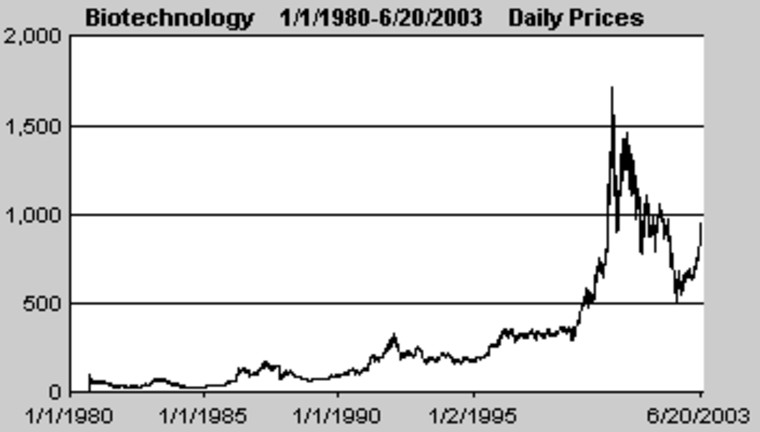With biotech stocks up 66 percent from their lows of last July, investors with a long memory have reason to be skeptical. In the past 30 years, the biotech industry has gone through more than its share of heady booms — followed by painful busts. But now, after decades of losing billions of dollars of investors’ money, biotech companies are bringing to market a flurry of new drugs that hold the promise of bringing profitability to a group of companies that has long struggled for survival on the cutting edge of the healthcare industry.

UNLIKE THEIR older, bigger, and better-financed cousins in the pharmaceutical industry, biotech firms have typically had to live hand to mouth as they struggled to fund new discoveries. For many biotech small firms, that’s still the case.
“One third of U.S. companies and about 30 percent of companies globally have less than one year’s worth of cash left in the bank,” said Mike Hildreth, who advises biotech firms for Ernst & Young. “That creates a significant challenge for them to find capital to continue to fund those innovative projects.”
If this boom collapses, it wouldn’t be the first time investors saw blood in the streets of the biotech sector. The industry has been the source of some of Wall Street’s most frenzied rallies — and some of its biggest downfalls — long before the Internet stole the show for high-flying stocks. Some of the more memorable biotech flameouts came after huge surges in 1983-84, 1987-88, 1992, and most recently in 2000, when the investors in biotech stocks lost more than two-thirds of their money.
InsertArt(1939295)But now, some industry analysts believe the biotech industry is slowly reaching the day when it will finally earn more cash than it burns — a milestone that will help dampen its dizzying booms and depressing busts. Industrywide, biotech revenues are growing at about 15 percent a year, said Hildreth, and he estimates that based on that growth, along with a “robust pipeline, more efficient product development and belt-tightening in the face of the current cash crunch,” the biotech industry could reach profitability within five years — for the first time in its nearly 30-year history.
Of course, several larger biotech firms, like Genetech and Amgen, have been in the black for years, thanks to a stable of money-making drugs that generate strong revenue growth and steady profits. But now, smaller firms are also thriving.

More than 50 biotech firms, or about 15 percent of those publicly traded in the U.S., posted profits in at least one year during the past three, according to a report released Monday by Ernst & Young. In the same period, more than 20 companies recorded sustained profitability over all three years, the report said.
Much of that profit is coming from a new wave of promising drugs, many of them targeting cancer, that have helped a host of smaller companies attract attention on Wall Street, as well as at the Food and Drug Administration.
“I, too, think this time the upswing for the industry is real,” Food & Drug Administration Commissioner Mark McClellan told the industry’s trade conference, BIO 2003, in Washington Monday. “There are a number of effective new treatments that have been approved and many more that may turn out to add more value to our healthcare system in the pipeline today.”
The choice of Washington as the site for this year’s Biotechnology Industry Organization Conference underscores the role that politics is playing in the industry’s current good fortune. As the pace of medical breakthroughs has quickened in the lab, so too has the approval for many new drugs. And news about a drug’s approval is the biggest mover of a biotech company’s stock.
For example, when Millennium Pharmaceuticals’ cancer drug, Velcade, was approved in May more quickly than expected, Millennium’s shares surged; the stock is up 121 percent since February. On the other hand, the failure of ImClone Pharmaceuticals to win approval for its cancer drug Erbitux, famously sent that stock plummeting, landing domestic diva Martha Stewart in hot water and ImClone CEO Sam Waksal in jail for selling their stock before news of the FDA’s decision was public.
“It’s always been the single most important value-creating event in a drug’s development,” said Piper Jafray biotech analyst Mark Schoenebaum. “There’s a perception that the FDA is more willing to approve certain types of drugs. (FDA Commissioner) Mark McClelland appears to be more tolerant of risk and willing to approve certain drugs more quickly.”
Those winning the swiftest approval tend to be remedies for life-threatening diseases for which there is no other alternative, said Schoenebaum. And with many biotech firms focused on cancer drugs, he said, they are more likely to win approval than, say, a big pharmaceutical company’s latest remedy for high blood pressure, for which there are already several approved medications.
As a signal of the White House’s support of the biotech industry, President Bush spoke to the group Monday — the first time a president has done so.

THE URGE TO MERGE
But the drug approval process can still take years. Paying for those trials, and marketing a drug once it’s approved, has often forced a biotech firm with a hot new drug to team up with a giant pharmaceutical company — in return for a big chunk of the profits. Now, biotech firms trying to bulk up and go it alone — one of the driving forces behind some of the industry’s biggest mergers, such as last year’s $10.3 billion combination of Amgen and Immunex, or Millennium Pharmaceuticals’ $2 billion deal with COR Therapeutics.
On Monday, Idec Pharmaceuticals said it would pay $6.5 billion in stock to acquire Biogen, as both companies face declining sales growth of blockbuster drugs. Biogen’s multiple sclerosis drug, Avonex, for example, has been hurt by Serono’s rival drug Rebif.
These mergers have begun to blur the line between biotech firms and their rivals, the pharmaceutical giants with huge research and development budgets and armies of salespeople.
”(Big pharmaceutical companies) have had plenty of success over the last 40 years, and with that a lot of cash they can spend on new research,” said SG Cowen biotech analyst Eric Schmidt. “But along with that goes (the downside of) patent expiration. While many biotech companies are still struggling, and are worrying where the next dollar is coming from, those that strike it rich are going to have it good for the next 10 or 20 years.”
Even the type of research pursued by big and small drug companies is changing.
“Pharmaceutical companies focus on small molecules — anything that goes in a pill,” said Schoenebaum. “Biotechs have focused on large molecules that require injection. But a lot of biotech companies are beginning to move into the small molecule space.”